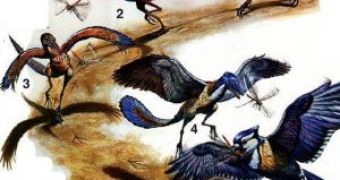Birds were known for a very long time to have emerged from dinosaurs, but more recently, researchers sniffed out many long-thought strictly avian traits inherited from dinosaurs: feathers, nesting, parental care.
Now, the difference between birds and dinosaurs gets even thiner as both groups were found to present the same short type of genome (total DNA sequences).
Relatively shorter genomes were linked to the flight ability. Birds, for instance, have 1.45 million base pairs and bats about 2.25 billion base pairs, both very short compared to other vertebrates (animals with backbones)
Humans genomes have about 3.25 billion pairs.
Also, flightless birds posses longer DNA sequences than flying birds.
The new research made at Harvard University contradicts this idea and shows that the shorter genomes of birds is a trait inherited from the saurischian dinosaurs, birds' ancestors, that include include the carnivorous theropod dinosaurs, like Tyrannosaurus rex (from which the birds evolved) and sauropod ones (the huge herbivorous long necked long tailed beasts).
"So rather than being a characteristic of birds or flying animals, short genomes should be thought of as a characteristic of dinosaurs, including the killer theropod dinosaurs. Birds just inherit that character like they have inherited other dinosaurian traits, like feathers," said Chris Organ, one of the researchers.
The majority of the studies on DNA length investigated the living species, which represent only about 1% of all animal species that have ever roamed the Earth.
The Harvard team compared 31 extinct dinosaur species looking at the relationship between cell size and genome size: larger cell sizes are linked with longer genomes.
The dinosaur genomes were estimated investigating dinosaur bone-cell sizes in slides, from the collection of Harvard University's Alfred Crompton and the Museum of the Rockies in Montana. These data were compared with other genome size estimations for 26 living four-limbed animals also realized from cell-size observations.
The researchers discovered that the short "bird-sized" genomes (of roughly 1.8 billion base pairs) emerged in saurischians between 230 and 250 million years ago, long before the appearance of Archaeopteryx and the other early birds.
The other group of dinosaurs, ornithischian dinosaurs (herbivorous like horned ceratopsian dinosaurs, armored dinosaurs or duck billed dinosaurs), had longer genomes, more similar to current crocodiles and alligators (about 2.5 or 3 billion base pairs).

 14 DAY TRIAL //
14 DAY TRIAL //